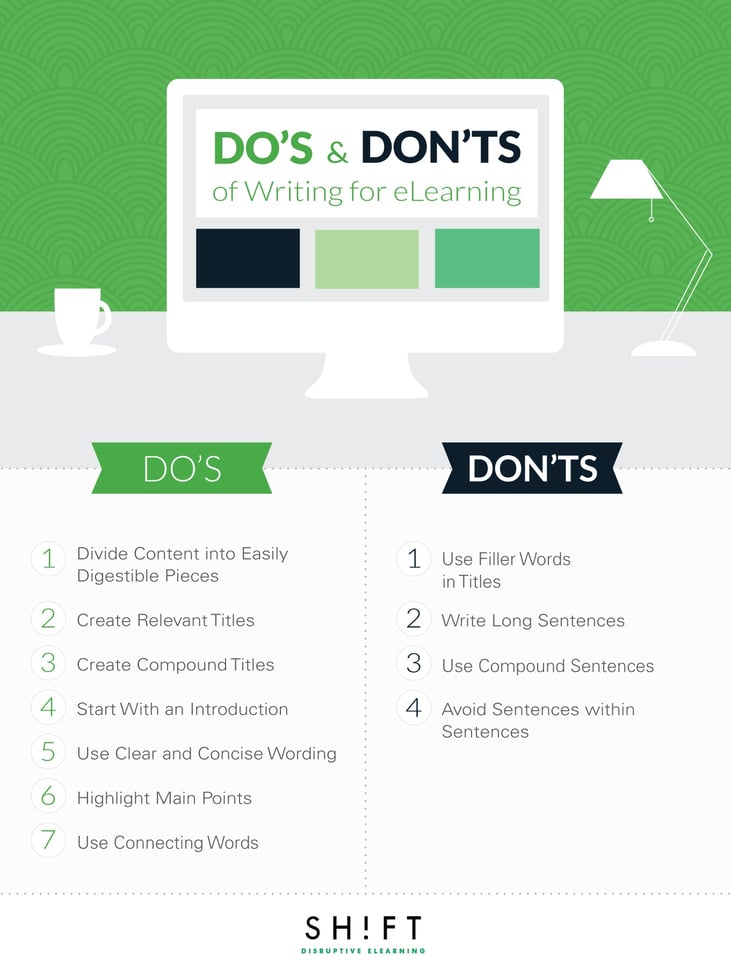Have you ever read something where it seems like the material was written by someone who simply wanted to show off how smart they are? When this happens, do you find yourself thinking how brilliant the author is? No, it’s far more likely that you get annoyed with the person who wrote the piece and possibly frustrated with yourself. This is NOT the way to write your courses.
As an eLearning designer, there will be times when you know the material far better than the average student, but the last thing you want to do is create a course that goes over students’ heads. You need to strive to be clear without talking down to your audience and engaging without being letting the entertainment value overshadow the information.
Additionally, there are certain things that you need to consider when designing for people who will be viewing your eLearning course on a computer screen or other device. People who are learning online have far more built-in distractions over people reading from a piece of paper, which makes online learners:
- Focus on tasks not an overall experience
- Read up to 25% slowerbecause there are distractions like links to click on
- Read only about 20% of text on the average page
- Skim information instead of reading every single word
Because of these factors, your eLearning courses must be concise and organized into easily manageable parts.

When writing for eLearning follow these do’s and don’ts and hopefully you'll obtain a greater impact:
Do: Divide Content into Easily Digestible Pieces
Breaking information up is known as “chunking” and it is best to do this by dividing content into topics to create a sequence that goes from simple to more in-depth concepts. By keeping subjects independent and adding a title to each, you are helping your students find info more quickly, which benefits their tendency to skim a page.
Numbering your subheadings is also a good idea especially if you have a number in your title, such as ‘9 Ways to Improve Your Writing.’ Numbering is good even if you don’t have a number in the title, though.
Read More: 4 Tips for Content Chunking in eLearning
Do: Create Relevant Titles
While fun or clever titles can be eye-catching and memorable, it is even more important that a title provides structure to your course. Once again, because students skim, a title is a good way to help them find the info they need. Titles also help give a good first impression to students about what is coming up.
Create titles by using “what, why how, or when” because these naturally trigger curiosity and lets them quickly know what will be answered in that section.
It is also a good idea to put relevant words close to the beginning of the title because students will see this first.
Non-Example → Decide on Ways to Test for Reading Level
Example → Reading Level: Deciding on How to Test
Do: Create Compound Titles
The colon (:) is your best friend when creating titles because it allows you to push the most meaningful words to the left and makes good, descriptive titles possible without making them too wordy. They also draw attention to the second half of the title, which can sometimes get ignored.
Example → Writing Styles: Concise vs. Creative
Don't: Use Filler Words in Titles
Short words like it, the, a, and, some have their place in our language for sure, but they don’t provide extra information, so they are quickly skimmed over and ignored. This is why you should limit them to your titles and especially should never start a title with one. Your writing will be far more concise and effective without them.
Quick notes on title writing:
- Headlines should be 4-7 words and summarize the screen.
- Bolding text makes it stand out and easier to find.
Non-example → The Colonization of America
Example → American Colonization
Read more: 7 Techniques for Reducing Wordiness in Your eLearning Courses
Do: Start with an Introduction
Unlike, for print writing, when you create online content you should put the most important info at the beginning. Because of this, it is a good idea to create an introduction or overview paragraph at the beginning of each slide or section to help organize all upcoming information.
Here're some tips:
- Even if your subject matter is short, you can include a brief overview that highlights the main points in 14-20 words.
- Make the intro boldface or in a larger font size. According to Conversionxl.com when people encounter a story with a boldface introductory paragraph, 95 percent of them viewed all or part of it.
Do: Use Clear and Concise Wording
Abstract language often refers to vague concepts and uses specialized lingo that takes a considerable time to get to the main point. Concrete langue gets to the point immediately, and this is what you should aim for.
When you do need to use special vocabulary, you should always give a definition the first time it is used. Acronyms and abbreviations should also be explained upon their first use. If you have several words like this that you are using, a glossary can be a good idea for quick reference.
While you shouldn’t talk down to your students, you still should avoid overly complicated or long words that will slow down their reading and comprehension.
Don't: Write Long Sentences
Going along with the concept of using concrete and easy to understand language, is the rule of not making your sentence structure overly complicated either. Long sentences force students to slow down and focus on wording versus learning.
In general, any sentence that is over 55 words becomes difficult to follow and understand so aim to have your sentences around 20-30 words. You should still vary your sentences to keep the writing flowing and interesting but if you are in doubt over a sentence, it likely needs to be shortened and/or rewritten.
Further Reason to Keep Sentences Short: A study found that 79% of people reading online will merely scan or skim content looking for particular phrases or words. Only 16% read every word. Big blocks of text simply won’t cut it with these readers so make sure you have skimmable material.
Tips for writing concise sentences:
- Focus on your main idea and make sure it is prominent within a paragraph of 3-5 sentences.
- Break-up long paragraphs and sentences into shorter ones.
- Speak plainly with concrete words.
Don't: Use Compound Sentences
But I like compound sentences you might be shouting! But you might have to butt out on this one because too many “ands” and “buts” in your sentences means you are likely making your sentences too long and hard to follow.
Whenever possible, write simple sentences that focus on a subject and verb. Compound sentences shouldn’t be taken out completely, but they should be limited to keep your writing flowing easily and make it scannable by online readers.
An abundance of commas and semicolons are also indicators that a sentence is too complicated. If you see this in your writing, consider rewriting to create a few shorter sentences.
Non-example → The course goals include identifying risk factors and triggers, which are found in a variety of personality types and subtypes.
Example → The course goals include identifying risk factors and triggers. These are found in a variety of personality types and subtypes.
Don't: Write Sentences within Sentences
Sometimes we can set off information within a sentence with commas to give us good context, but this often creates a sentence that is far too long and complicated. Readers will often finish the sentence and be more confused by the explanatory text than if it was not there at all. Instead of using comas or parentheses to incorporate this info, consider writing it into a completely new sentence.
Always keep in mind that your course should be more like a conversation, not literature and you should write more as you are speaking. Description, clauses, and other phrases add some context, but they don’t always help get your point across.
Do: Highlight Main Points
When it doubt, bold it! If something like an idea, word or points are important the easiest and the best way to set them apart is to bold them. Only individual words or phrases should be bolded. Bolding entire sentences will defeat your point of trying to bring attention to certain ideas.
Anticipatory phrases like “Remember…,” “It should be noted that…” can bring attention to certain concepts as well. Bullet points are also effective for highlighting.
Do: Use Connecting Words
Connecting words allow you to connect the idea from one sentence to another without actually keeping them as one sentence. They can even be used to connect or link paragraphs.
- Use number/order words like “first,” “furthermore,” and “finally” to present a list or sequence. Just keep in mind that if you use a “first”, you must also tell what comes “Secondly” and “lastly.”
- Casual connectors like "therefore", "since", and “consequently”, are good at the beginning of a sentence or within a sentence.
- Quandary connectors help when you need to tell about a problem or solution to a problem. These include “however,” and “on the contrary.”
Overall, you need to keep it simple. That is probably the best, simplest thing I can advise. You need to be able to edit your work and consider if it is truly understandable to people who aren’t you. Taking a break from your work and then coming back to edit is a good way of getting perspective and tuning your editing eye. Cut what isn’t relevant or as the novelist, Elmore Leonard, said, “Try to leave out the parts that people skip.”
REFERENCES:
Franco, G. (2008). Cómo escribir para la web. Recuperado el 5 de abril del 2015 en:
Asinsten, J. (s.f.). Producción de contenidos para Educación Virtual. Recuperado el 20 octubre del 2013 en: https://virtualeduca.org/documentos/manual_del_contenidista.pdf
Ghirardini, B. (2014). Metodologías de e-learning (2014). Recuperado el 10 de abril del 2015
Make Your Writing Clearer: 6 Tips for Rewording Sentences



